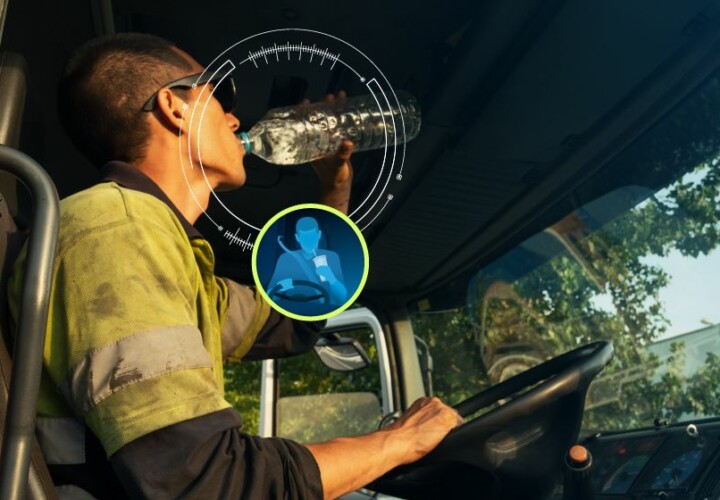As new technology steadily reshapes the landscape of fleet management, AI distraction cameras have become an industry buzzword. Everybody’s talking about them, and for good reason.
However, despite their growing popularity and undeniable benefits, there are several misconceptions around the contemporary technology.
In this blog post, we address the six most common myths surrounding one of today’s most popular forms of video telematics, AI distraction cameras.

Myth 1: Smart dash-cams violate privacy regulations
One of the biggest concerns about AI distraction cameras is the potential violation of privacy regulations.
Modern AI cameras are designed with privacy in mind, including GDPR. Devices can be configured to provide audio alerts, control access to footage, set data retention timescales and enable – or disable – in-cab recording, all of which ensures compliance across various authorities.
Contrary to popular belief, most AI cameras do not use facial recognition so cannot ‘recognise’ who is driving. They simply detect risky behaviours and alert drivers accordingly.
By choosing configurable AI cameras, fleets can enhance safety without compromising driver privacy.
Fast fact: Did you know that 84% of Fleet Managers agree that poor driving behaviour has a negative impact on their business?
Myth 2: My drivers won’t like having a camera in their cab
Whilst some drivers are initially unsure about in-cab cameras, education around the topic or the swift exoneration of a colleague due to captured footage, can often highlight the huge benefits they can realise.
AI distraction cameras play a crucial role across transport operations and are worth their weight in gold when it comes to protecting drivers from false claims and providing more focused training material.
Additionally, when coupled with vehicle multi-camera systems that show views around the whole vehicle exterior, AI cameras offer better protection and security for drivers, which helps increase their willingness to embrace the technology.
Fast fact: Did you know that just 2% of incidents recorded on four-way cameras result in disputed claims, versus an industry average of 40%?
Myth 3: I don’t need an AI dashcam because I have telematics
Telematics systems provide valuable data on vehicle usage and driver behaviour, but they do not capture visual context.
AI distraction cameras bridge this gap by recording incidents as they happen, detecting risk and alerting the driver to help reduce the risk of an incident. This provides evidence that can protect both drivers and the company’s brand reputation.
It offers a visual understanding of events, which is crucial for accurate incident assessment and prevention.
Allowing drivers to be proactive, AI distraction cameras provide a First Notification of Risk (FNOR) as opposed to a First Notification of Loss (FNOL), providing insights on what is happening now, target indicators of risk, tools to combat distraction and, perhaps most importantly, choice for the driver.
Fast fact: Did you know that drivers using mobile phones are approximately four times more likely to be involved in a crash than drivers not using a mobile phone?
Myth 4: Why should I worry about a near miss? Nothing happened!
Addressing near misses is more important than you might think. While they haven’t resulted in an accident, it often signals risks with driver behaviour that could lead to serious incidents in the future.
AI distraction cameras can identify risky behaviours and conditions leading to these near misses, making it possible to implement proactive measures to prevent actual accidents.
Understanding and analysing these incidents can significantly enhance overall fleet safety.
Fast facts: Did you know that in the UK nearly 2,000 people lose their life as a result of distracted driving, and 27,000 are seriously injured?
Myth 5: AI distraction cameras are too expensive
When you consider the potential costs associated with road accidents – including vehicle repairs, insurance claims and reputational damage – investing in AI distraction cameras is more than just economically viable.
AI camera systems have been proven to significantly reduce accident rates and associated costs and can contribute to longer vehicle lifespans and lower insurance premiums, offering a high return on investment.
Fast fact: Did you know that almost 75% of the time, a collision is not the driver’s fault, but the driver will still receive the blame? Video tells the truth and helps to exonerate drivers who are not at fault.
Myth 6: Installing an AI distraction camera will mean replacing all my kit
This is another common myth – transport operators do not need change their existing systems to bring video telematics into the mix.
Modern solutions are designed for easy installation with minimal disruption and these systems can seamlessly integrate with existing telematics through APIs, allowing fleet managers to work efficiently with both old and new technologies.
Fast fact: Did you know that AI distraction cameras can help achieve up to 80% reduction in mobile phone distractions, 51% reduction in collisions, 81% reduction in smoking and 76% reduction in near collisions?
In conclusion...
AI distraction cameras are not just a solution for monitoring driver behaviour; it’s a sophisticated technology that enhances driver safety, provides indisputable evidence in the face of incidents and helps manage fleet operations more effectively.
By debunking these myths, we hope to foster a better understanding of video telematics’ benefits, encouraging more fleets to adopt this technology to secure their operations and protect their drivers.
To find out more about Microlise’s AI distraction camera offering, click the button below.




